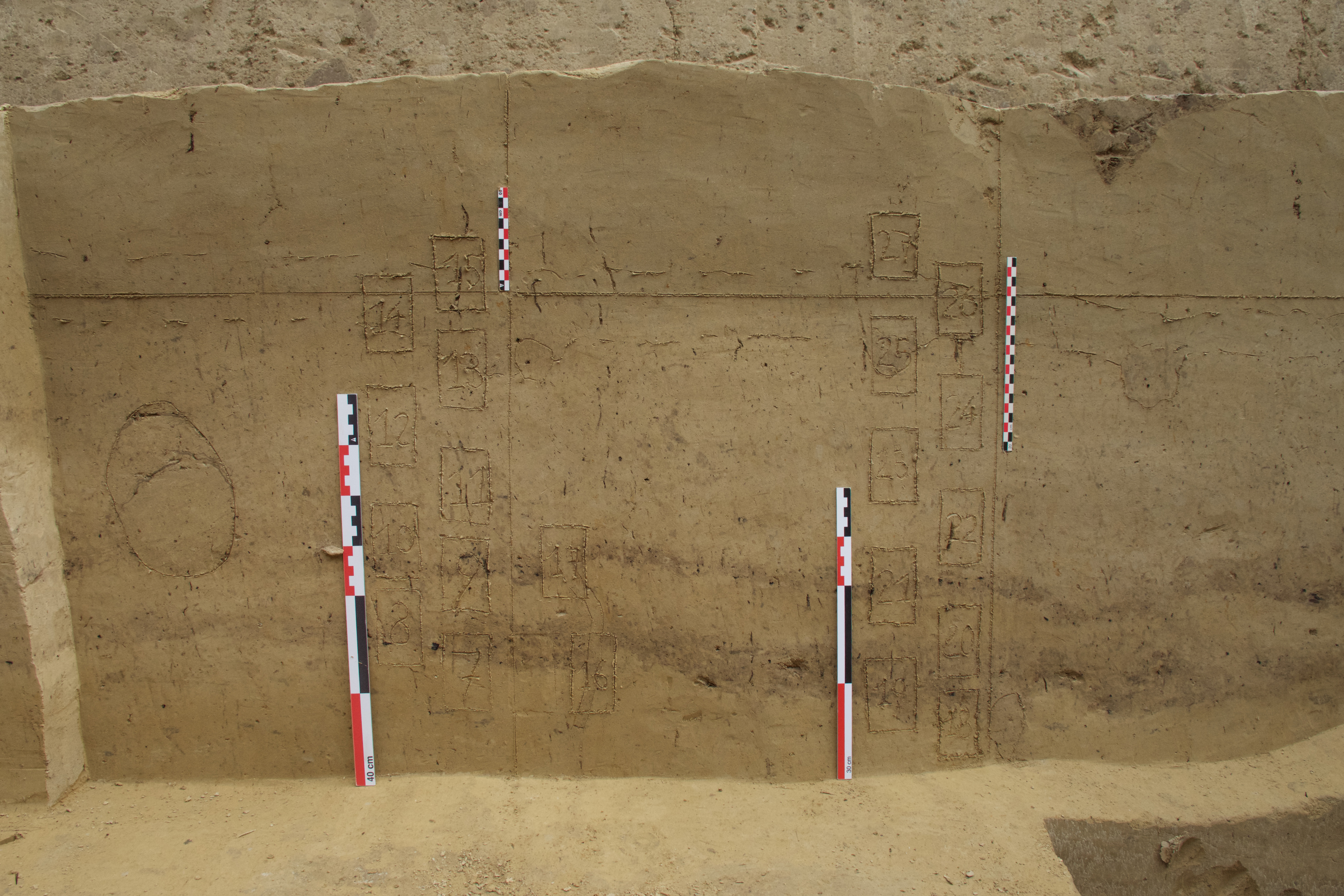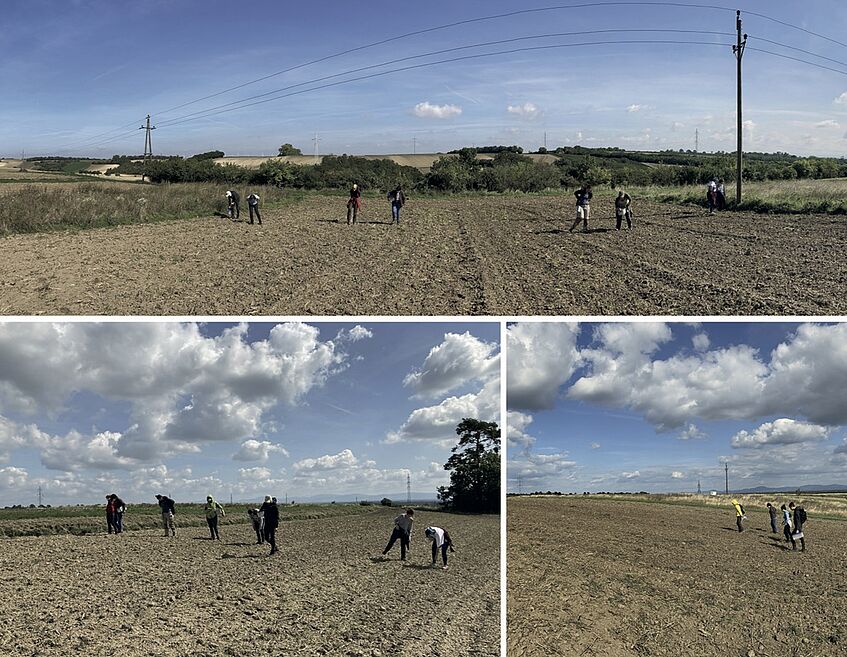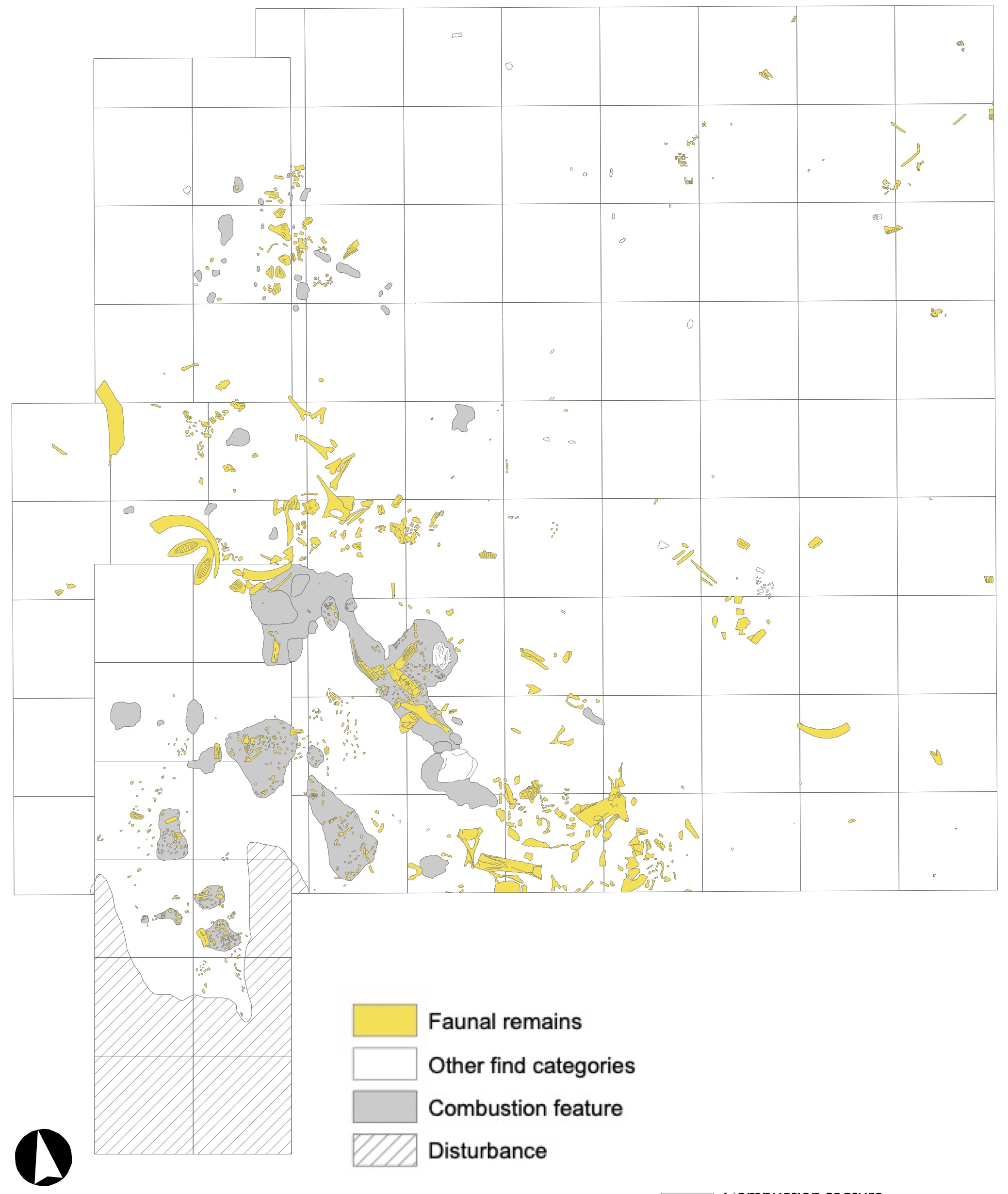Grub-Kranawetberg I

Section of the 2021 excavation at Grub-Kranawetberg I
Grub-Kranawetberg I, a multi-layered Gravettian site, is located approximately 30 km northeast of Vienna in Lower Austria. It is situated 196 m above sea level on the southern slope of a hill framed in the north and south by small creeks leading into the nearby Morava (March) river valley. While the site is known from surface collections since the 1970s, new surface finds in 1993 made a first rescue excavation necessary. From 1993 to 2011 fieldwork directed by Walpurga Antl-Weiser (Natural History Museum Vienna) has exposed a total of ~270 m2 in several trenches. The PalArchGroup team worked at the site in 2021 conducting a fieldwalking survey and a small excavation.
The surrounding of the excavation site - understanding the surface scatter of finds around the site
In 2021 we conducted a fieldwalking survey around the site Grub-Kranawetberg I. We surveyed around 126,000 square metres using GNSS (Global Navigation Satellite System) to piece-plot each find. In total, we recovered 359 finds comprising lithic artefacts and faunal remains. Our analysis shows that the state of the fields (ffreshly ploughed, ploughed a while ago, etc.) did not drive how many finds per cadastral parcel were recovered during our survey and did not bias the find density per cadastral parcel. The majority of finds hint at a Gravettian dating and occur in two concentrations on top of the hill west of the known site Grub-Kranawetberg I.
The 2021 survey (and its analysis) was co-funded by the University of Vienna and the Land Niederösterreich, Abteilung Wissenschaft und Forschung (project K3-F-530/005-2021).
Nigst, P. R., Antl-Weiser, W., & Bosch, M. D. (2024). Exploring the Surrounding of a Gravettian Site. The Case Study Grub-Kranawetberg, Austria. Archaeologia Austriaca. 10.1553/archaeologia108
Nigst, P. R., Antl-Weiser, W., & Bosch, M. D. (2024). Neue Feldforschungen am Kranawetberg – Oberflächenaufsammlungen um die Fundstelle Grub-Kranawetberg. Archäologie Österreichs, 31-32, 27-30. Link to publication

Photos of fieldwalking survey in September 2021 (Photos: P. R. Nigst), changed after original figure in: austriaca.at/0xc1aa5576_0x003f2ff4.pdf
The excavated part of the site comprises two main areas:
- a bone accumulation with remains of mammoth and wholly rhino
- a 'campsite' area with combustion and pit features and a high density of archaeological finds.

Map of the bone accumulation area.
Bone accumulation
The bone accumulation is situated about 20 m southwest of the campsite area. The deposit is dominated by Mammuthus primigenius but also includes Coelodonta antiquitatis, Rangifer tarandus, Equus sp., Megaloceros giganteus, Canis lupus, Ursus cf. arctos and Lepus cf. timidus. The presence of butchery marks on remains of both megafaunal taxa indicates a human accumulated assemblage. The absence of carnivore gnaw marks suggests that humans had primary access to meaty skeletal parts. An indication that humans occupying the adjacent campsite interacted with the bones is seen in the rearticulation of a left upper first molar of a mammoth from the campsite with its matching right first upper molar found in the bone accumulation. The deposit is further characterized by various indications of fire evident in lenses of burned sediment and abundant traces of heating faunal remains. The varied colours of burned bone, as well as reddish burned loess show that the accumulation was subjected to a wide range of fire temperatures. The results of zooarchaeological, taphonomic, and spatial analyses of this assemblage offer evidence on both human subsistence and formation of such a mammoth bone accumulation; they further allow us to argue for the intentional use of fire as waste removal strategy.
Bosch, M. D., Nigst, P. R., Fladerer, F. A., & Antl-Weiser, W. (2012). Humans, bones and fire: Zooarchaeological, taphonomic, and spatial analyses of a Gravettian mammoth bone accumulation at Grub-Kranawetberg (Austria). Quaternary International, 252, 109 - 121. https://doi.org/10.1016/j.quaint.2011.08.019
'Campsite' area
The campsite area is characterised by at least four archaeological horizons (AH 1 to 4). AH 4 is the richest of the three archaeological horizons and includes two combustion features and a set of pit structures around those combustion features. It is also rich in lithic and faunal remains, including >250 ivory beads of different shapes. In general, the intense exploitation of ivory is evident in AH 4. The assemblage also includes two deciduous teeth of modern humans.
Antl-Weiser, W. (1999). Paläolithischer Schmuck von der Gravettienfundstelle Grub/Kranawetberg bei Stillfried, Niederösterreich. Annalen des Naturhistorischen Museums in Wien. Serie A für Mineralogie und Petrographie, Geologie und Paläontologie, Anthropologie und Prähistorie, 101, 23-41.
Antl-Weiser, W., Fladerer, F. A., Nigst, P. R., & Verpoorte, A. (2010). Grub/Kranawetberg (Lower Austria) – Insights into a Gravettian Micro-region in Eastern Austria. In C. Neugebauer-Maresch & L. R. Owen (Eds.), New Aspects of the Central and Eastern European Upper Palaeolithic - methods, chronology, technology and subsistence (Vol. 72, pp. 231-243). Verlag der Österreichischen Akademie der Wissenschaften.
Antl, W., & Fladerer, F. A. (2004). Outlook to the East: the 25 ky BP Gravettian Grub/Kranawetberg Campsite (Lower Austria). In J. A. Svoboda & L. Sedlácková (Eds.), The Gravettian along the Danube, Proceedings of the Mikulov Conference, 20.-21. November, 2002 (Vol. 11, pp. 116-130). Archeologický ústav AV CR.
Antl, W. (2013). The inventories of archaeological horizons 4 and 3 and the loess section of Grub/Kranawetberg, a Gravettian site in Lower Austria. E&G Quat. Sci. J, 62, 120-126.
Antl, W., & Bosch, M. D. (2015). The use of invory at the Gravettian site Grub/Kranawetberg, Lower Austria. Anthropologie, LIII(1-2), 233-244.
Antl-Weiser, W., & Teschler-Nicola, M. (2000). Die menschlichen Zahnfunde von der Gravettienfundstelle Grub/Kranawetberg bei Stillfried an der March, Niederösterreich. Archaeologia Austriaca, 84-85, 201-212.
Nigst, P. R., & Antl-Weiser, W. (2011). Intrasite Spatial Organization of Grub/Kranawetberg: Methodology and Interpretations - Insights into the Spatial Organization of Gravettian Sites in Eastern Central Europe. In S. Gaudzinski-Windheuser, O. Jöris, M. Sensburg, M. Street, & E. Turner (Eds.), Site-internal spatial organization of hunter-gatherer societies: Case studies from the European Palaeolithic and Mesolithic (pp. 11-29). Verlag des RGZM.
Nigst, P. R., & Antl-Weiser, W. (2012). Les structures d’occupation gravettiennes en Europe centrale : le cas de Grub/Kranawetberg, Autriche. L’Anthropologie, 116(5), 639 - 664. https://doi.org/10.1016/j.anthro.2012.09.001
The 2021 fieldwork project was co-directed by Marjolein D. Bosch (Austrian Archaeological Institute), Philip R. Nigst (University of Vienna), and Walpurga Antl-Weiser (NHM Vienna). Other team members are: Stéphane Pirson (AWaP), William Chase Murphree (ICArEHB - Interdisciplinary Center for Archaeology and the Evolution of Human Behaviour, University of the Algarve), Carolina Mallol (University of La Laguna), and Margarita Jambrina-Enríquez (University of La Laguna).
Are you an undergraduate, Master or PhD student looking for materials for your dissertation? - If so, please get in contact to discuss interests and options.
The research since 2021 is funded by the University of Vienna (Rectorate and Dean’s Office of the Faculty of Historical and Cultural Studies) and the government of Lower Austria (Land Niederösterreich, Abteilung Wissenschaft & Forschung).


All photos © Marjolein D. Bosch, Philip R. Nigst and Walpurga Antl-Weiser, unless otherwise stated.
